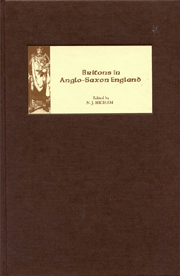Book contents
- Frontmatter
- Contents
- List of Illustrations
- List of Tables
- Contributors
- Dedication
- Acknowledgements
- Abbreviations
- 1 Britons in Anglo-Saxon England: An Introduction
- 2 Anglo-Saxon Attitudes
- 3 Forgetting the Britons in Victorian Anglo-Saxon Archaeology
- 4 Romano-British Metalworking and the Anglo-Saxons
- 5 Invisible Britons, Gallo-Romans and Russians: Perspectives on Culture Change
- 6 Historical Narrative as Cultural Politics: Rome, ‘British-ness’ and ‘English-ness’
- 7 British Wives and Slaves? Possible Romano-British Techniques in ‘Women's Work’
- 8 Early Mercia and the Britons
- 9 Britons in Early Wessex: The Evidence of the Law Code of Ine
- 10 Apartheid and Economics in Anglo-Saxon England
- 11 Welsh Territories and Welsh Identities in Late Anglo-Saxon England
- 12 Some Welshmen in Domesday Book and Beyond: Aspects of Anglo-Welsh Relations in the Eleventh Century
- 13 What Britons Spoke around 400 AD
- 14 Invisible Britons: The View from Linguistics
- 15 Why Don't the English Speak Welsh?
- 16 Place-Names and the Saxon Conquest of Devon and Cornwall
- 17 Mapping Early Medieval Language Change in South-West England
- Index
7 - British Wives and Slaves? Possible Romano-British Techniques in ‘Women's Work’
Published online by Cambridge University Press: 12 September 2012
- Frontmatter
- Contents
- List of Illustrations
- List of Tables
- Contributors
- Dedication
- Acknowledgements
- Abbreviations
- 1 Britons in Anglo-Saxon England: An Introduction
- 2 Anglo-Saxon Attitudes
- 3 Forgetting the Britons in Victorian Anglo-Saxon Archaeology
- 4 Romano-British Metalworking and the Anglo-Saxons
- 5 Invisible Britons, Gallo-Romans and Russians: Perspectives on Culture Change
- 6 Historical Narrative as Cultural Politics: Rome, ‘British-ness’ and ‘English-ness’
- 7 British Wives and Slaves? Possible Romano-British Techniques in ‘Women's Work’
- 8 Early Mercia and the Britons
- 9 Britons in Early Wessex: The Evidence of the Law Code of Ine
- 10 Apartheid and Economics in Anglo-Saxon England
- 11 Welsh Territories and Welsh Identities in Late Anglo-Saxon England
- 12 Some Welshmen in Domesday Book and Beyond: Aspects of Anglo-Welsh Relations in the Eleventh Century
- 13 What Britons Spoke around 400 AD
- 14 Invisible Britons: The View from Linguistics
- 15 Why Don't the English Speak Welsh?
- 16 Place-Names and the Saxon Conquest of Devon and Cornwall
- 17 Mapping Early Medieval Language Change in South-West England
- Index
Summary
SPINNING and weaving are believed to have developed as women's crafts because they were compatible with child rearing; they were interruptible tasks, like food preparation and other domestic chores. Given the high proportion of hours that must be spent spinning in order to support weaving, about 10:1, anyone available may have been recruited to spin, including children and old men no longer capable of heavy work. Nevertheless, textile implements from furnished Anglo-Saxon graves – spindle whorls and weaving beaters, shears and needles – are gendered, feminine possessions. Weaving, from classical antiquity at least, is presented in art and text as women's work, until the introduction of the horizontal loom into western Europe about AD 1000. This loom was operated by treadles, and its inception marks the beginning of mechanization and industrialization. It was a man's instrument. Before that watershed, and even after the horizontal loom's introduction, women wove on a vertical loom, and their weaving was probably of ten communal. An illustration in the ninth-century, Carolingian Utrecht Psalter, copied more clearly in the twelfth-century, English Eadwine Psalter, shows this collaborative, women's world. The woman on the left holds the end of a skein of thread on a forked stick, gesturing animatedly to her companion who holds a pair of shears. Two women work at a two-beam vertical loom. They are probably preparing the warp: one woman, kneeling, spreads the warp threads with her fingers; she holds what looks like a comb with an angled handle in her other hand.
- Type
- Chapter
- Information
- Britons in Anglo-Saxon England , pp. 80 - 90Publisher: Boydell & BrewerPrint publication year: 2007



